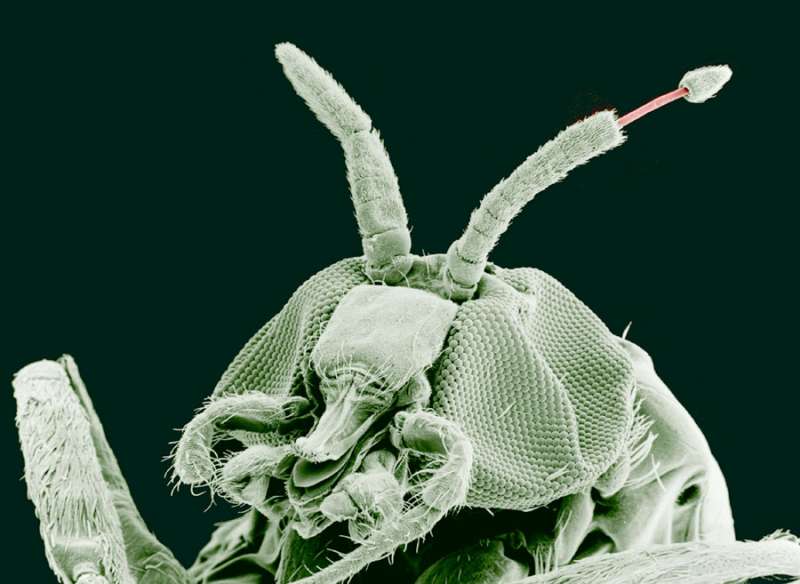Adult Black Fly (Simulium yahense) with (Onchocerca volvulus) emerging from the insect's antenna. Credit: Public Domain
Scientists have sequenced the genome of the parasitic worm responsible for causing onchocerciasis—an eye and skin infection more commonly known as river blindness. Through their work, researchers have gained insight into the workings of the parasite and identified proteins that potentially could be targeted with existing drugs or provide areas for developing new treatments and a preventive vaccine. The research, which is described in a pair of papers published this week in Nature Microbiology, was conducted in part by scientists employed or supported by the National Institute of Allergy and Infectious Diseases (NIAID), part of the National Institutes of Health.
The World Health Organization (WHO) estimates that river blindness currently affects an estimated 18 million people worldwide, predominantly in sub-Saharan Africa. The disease occurs among humans through the bite of blackflies that live and breed on the banks of fast-flowing rivers and streams. These flies transmit Onchocerca volvulus, the tiny parasitic worm responsible for river blindness. Once inside the human body, the worms reproduce. Their offspring migrate to the skin, where they cause intense itching and rashes, and to the eye where they cause ocular symptoms and, ultimately, blindness. The infection is commonly treated using the anti-parasitic medication ivermectin. However, a complete cure can require decades of treatment, and some researchers are concerned that widespread use of ivermectin may cause the worms to develop resistance to the drug. Additionally, ivermectin can cause severe side effects in patients who also have Loa loa, another parasitic worm infection.
In the newly published research, the scientists describe sequencing the complete genomes of O. volvulus worms gathered from Ecuador, Uganda and West Africa. Additionally, they reconstructed the genetic makeup of Wolbachia, the symbiotic bacteria that lives within the worms.
By examining the genomes of the worms and their symbiotic bacteria, the researchers were able to identify genes that coded for common proteins and molecular reactions essential to infection. 16 of the newly discovered proteins look promising as targets for existing drugs not currently used as treatments for river blindness, adding to the potential new medications for the disease. Further, the authors note, the protein data will accelerate development of new treatments for river blindness as well as other diseases associated with parasitic worm infections.
More information: James A. Cotton et al. The genome of Onchocerca volvulus, agent of river blindness, Nature Microbiology (2016). DOI: 10.1038/NMICROBIOL.2016.216
Young-Jun Choi et al. Genomic diversity in Onchocerca volvulus and itsWolbachia endosymbiont, Nature Microbiology (2016). DOI: 10.1038/NMICROBIOL.2016.207
Journal information: Nature Microbiology




















